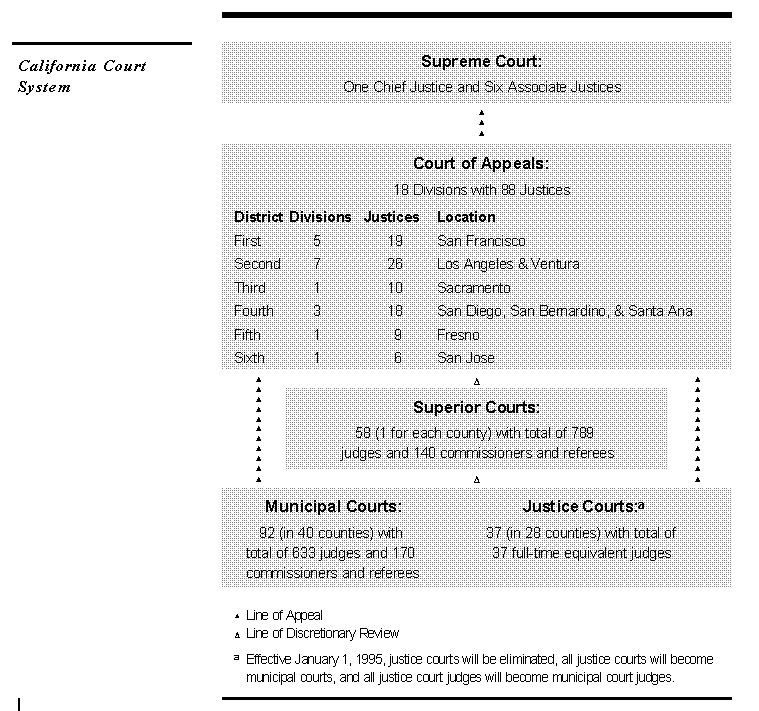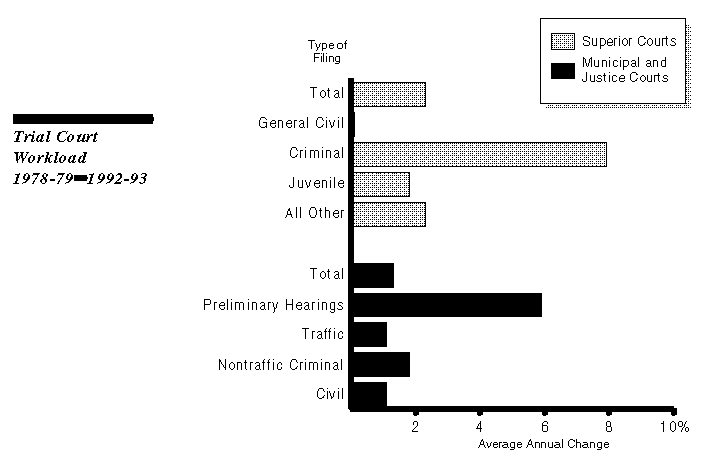
 Legislative Analyst's Office
Legislative Analyst's Office
The Judiciary is California's third branch of government. It consists of more than 1,500 judges who sit in almost 200 different courts. The court system is divided between trial courts (which include municipal, justice courts, and superior courts) and appellate courts. Both types of courts handle criminal and civil cases.
Municipal and justice courts have limited jurisdiction that includes some civil cases (disputes of $25,000 or less), small claims, residential evictions, all misdemeanors and infractions, and preliminary felony proceedings. Proposition 191 (SCA 7, Dills), which was approved by the voters in November 1994, will eliminate the distinction between municipal and justice courts on January 1, 1995. After that time, all justice courts will become municipal courts.
Each of the state's 58 counties has a superior court. The superior courts review decisions by lower courts and handle larger civil cases (disputes of more than $25,000), family law, juvenile law, probate law, and final felony proceedings.
The Judicial Council, which has 21 members and is chaired by the Chief Justice of the Supreme Court, oversees the state's judicial business. The council makes recommendations to the courts, the Governor, and Legislature on the operations of the courts, and adopts rules for court administration, practice, and procedure.

There have been major increases in the number of cases processed by California's courts over the past 15 years. The greatest increases have been in criminal cases. Since 1978- 79 criminal case filings increased by 65 percent in superior courts, or at an average annual rate of 8 percent. In municipal and justice courts, criminal filings (felony preliminary hearings and nontraffic cases) increased by 40 percent.

The increase in trial court workload has been accommodated, in part, by creation of new judgeship positions by the Legislature and the Governor. However, no new judgeship positions have been created to handle the additional court workload since 1988. The cases per judge in superior court have remained relatively stable since 1961, (primarily due to adding superior court judgeships) but have increased by about 72 percent in municipal and justice courts.
In comparing the state's trial court workload with other states, California ranks near the middle of the 50 states in civil case filings and in the bottom one-third for criminal case filings.
The state funds the appellate courts. Funding for the trial courts, however, is provided by both the state and counties. Funding for courts has grown substantially in recent years, with the state taking a much larger role in funding of the trial courts through the Trial Court Funding Program. From 1984-85 to 1991-92, state funding for trial courts increased tenfold. State funding for appellate courts increased by about 200 percent.
In the past three years, however, the state's General Fund support of the trial courts has declined. At the same time, revenues from fines, fees, and forfeitures that previously were used by local governments to support court operations are now transmitted to the state General Fund and the Trial Court Trust Fund to offset the state's support.
